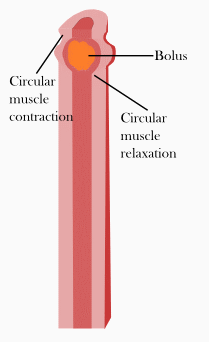Peristalsis

La peristalsis (del griego peristallein) o peristaltismo es el proceso por el cual se producen una serie de contracciones y relajaciones radialmente simétricas en sentido anterógrado a lo largo del tubo digestivo y los uréteres, llamadas ondas peristálticas. Estas pueden ser primarias, secundarias o terciarias. Su función es movilizar los alimentos a través del aparato digestivo, así como la orina desde los riñones a la vejiga, o la bilis desde la vesícula biliar hasta el duodeno.[1]
Las fibras musculares lisas son las responsables de esta acción fisiológica. La peristalsis intestinal es también conocida como motilidad gastrointestinal, aunque el término peristalsis por sí solo suele referirse generalmente a este último.[2]
Es una respuesta refleja que puede aumentar o disminuir por impulsos nerviosos autónomos.
Fisiología
[editar]La peristalsis fue descrita por Bayless y Starling hace 120 años, cuando descubrieron que el proceso de inhibición/relajación inicial, seguido de excitación/contracción son las características distintivas de la peristalsis.[3]
En el momento en el cual el esófago recibe el bolo alimenticio, después de la deglución, este emite una señal nerviosa al tronco cerebral, el cual se encarga de coordinar los movimiento peristálticos. Este proceso ocurre en unos 4 a 10 segundos.[cita requerida]
En contraposición, los movimientos antiperistálticos son los que se producen en sentido retrógrado, causando el vómito.
La linfa se mueve a lo largo de vasos linfáticos por acción peristáltica.
El semen baja el conducto deferente durante la eyaculación por movimientos peristálticos.
La peristalsis está presente en los animales, tanto invertebrados como vertebrados.
Véase también
[editar]Referencias
[editar]- ↑ Peristaltismo, Definición. MedLinePlus.
- ↑ William O. Reece (21 de marzo de 2013). Functional Anatomy and Physiology of Domestic Animals. John Wiley & Sons. pp. 451-. ISBN 978-1-118-68589-1.
- ↑ Muta K.; Mittal RK.; Zifan A. (2022). «Rhythmic contraction but arrhythmic distension of esophageal peristaltic reflex in patients with dysphagia.». PLoS ONE 17 (1): e0262948. doi:10.1371/journal.pone.0262948. Consultado el 11 de febrero de 2022.
Enlaces externos
[editar]- Interactive 3D display of swallow waves at menne-biomed.de
- MeSH: Peristalsis (en inglés)
- Physiology: 6/6ch3/s6ch3_9 - Essentials of Human Physiology
- Overview at colostate.edu
Text is available under the CC BY-SA 4.0 license; additional terms may apply.
Images, videos and audio are available under their respective licenses.

